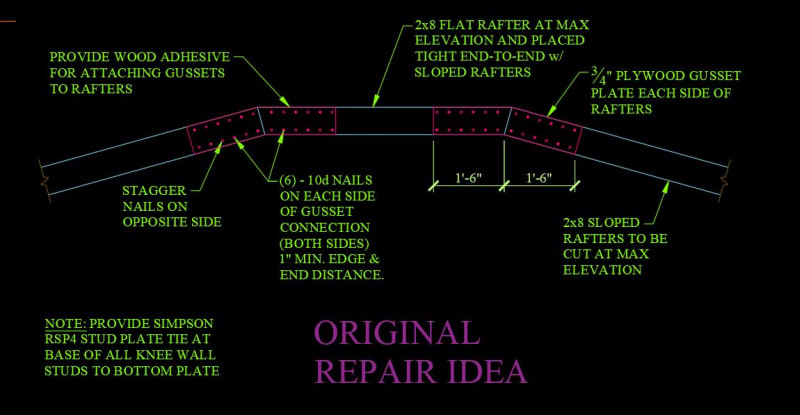jerseyshore
Structural
- May 14, 2015
- 912
As I mentioned in my other thread, the real reason I went out to this house was because they framed the roof ridge 9" too high. We have to cut down the roof ridge and the contractor was throwing out some options on how to do it. It's a low slope roof so 9" of vertical cut is 5'-5" horizontally.
The challenge here, besides the obvious, is that they:
1. Already sheathed the entire thing, so they want to save the 2x8 rafters as currently positioned, just cut off at that max height mark
2. Also have to keep 7' ceiling height to keep this a finished space for appraisal
The only way to keep this 7' ceiling height is to use 2x6's at the flat portion. Here is what the contractor described:
Option 1: lap 2x6 on each side of the now cut rafter pair, thru-bolt together
Option 2: Similar to OPT 1, but add a structural ridge beam down the center and hang the 2x6's off of it. Would need a triple 2x6 hanger since it'll be 3 ply wide basically.
My original repair included marrying new 2x8's end to end and using a plywood gusset (like a steel bent frame), but that won't give them 7' clear and the contractor doesn't think he can make the cuts that nice at the joints. I've included that below also.
Thoughts on this dilemma we have here? Any suggestions are greatly appreciated.



The challenge here, besides the obvious, is that they:
1. Already sheathed the entire thing, so they want to save the 2x8 rafters as currently positioned, just cut off at that max height mark
2. Also have to keep 7' ceiling height to keep this a finished space for appraisal
The only way to keep this 7' ceiling height is to use 2x6's at the flat portion. Here is what the contractor described:
Option 1: lap 2x6 on each side of the now cut rafter pair, thru-bolt together
Option 2: Similar to OPT 1, but add a structural ridge beam down the center and hang the 2x6's off of it. Would need a triple 2x6 hanger since it'll be 3 ply wide basically.
My original repair included marrying new 2x8's end to end and using a plywood gusset (like a steel bent frame), but that won't give them 7' clear and the contractor doesn't think he can make the cuts that nice at the joints. I've included that below also.
Thoughts on this dilemma we have here? Any suggestions are greatly appreciated.




